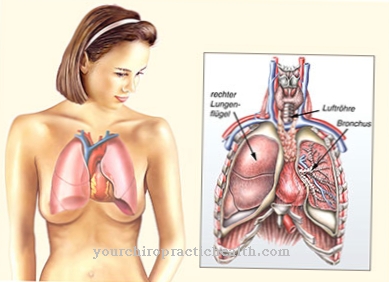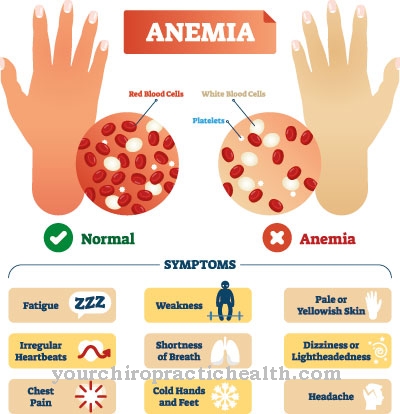Vocal cord paralysis Not only does it affect or prevent the voice, it can also lead to dangerous shortness of breath. Inflammation, cancer or vascular damage can be the causes. Therefore, medical treatment is always indicated if symptoms of vocal cord paralysis occur.
What is vocal cord paralysis?

Vocal cord paralysis refers to a functional restriction in the various muscles of the larynx. The vocalis muscle (vocal muscle), which, as part of the internal larynx muscles, adjusts the tension in the vocal cords, is particularly affected. The doctor speaks of one Recurrent palsy. Recurrens is the abbreviation for "Nervus laryngeus recurrens", in German called "Reverse larynx nerve".
A paresis is a paralysis that is not fully developed. However, vocal cord paralysis can also be based on a total failure of the recurrence and is then a so-called "paralysis".
The vocal cord paralysis basically occurs in 2 forms:
1. One-sided, due to the paralysis of only one vocal cord, the glottis becomes asymmetrical
2. On both sides, due to the paralysis of both vocal cords, the glottis remains symmetrical
Clear differences in the symptoms separate the two variants of vocal cord paralysis.
causes
The Vocal cord paralysis The cause is usually caused by operations on the thyroid gland. If the filigree recurrence is mechanically damaged, the result is a disruption of the conduction of stimuli to the larynx muscles.
Tumors of the thyroid gland and in the upper chest area can also attack the recurrence. Because the left recurrence runs from the brain (branching off from the vagus nerve), initially descending between the esophagus and the trachea, then bends back to the larynx (hence the term "retrograde" - it is noteworthy that the right recurrence deviates from the course described) .
Because of this “detour”, this nerve is susceptible to diseases not only of the neck, but also of the upper chest area. Therefore, an aortic aneurysm (bulging of the main artery) can also damage the recurrence. Finally, there are inflammations of the nerves that affect the recurrence. The result is ultimately vocal cord paralysis.
Symptoms, ailments & signs
Depending on whether the disorder occurs on one or both sides and the position in which the paralyzed vocal cords are, different symptoms can occur. Typically, vocal cord paralysis leads to hoarseness and voice disorders. The voice can no longer be heavily strained before the hoarseness mentioned and finally the temporary loss of voice occurs.
The breath is usually very noisy, and the noises can range from rattling to panting. This can also lead to dry coughs and swallowing disorders. As a result of the restricted supply of oxygen, what is known as hunger for air occurs, in which those affected seem to gasp for air. In addition, the vocal cord paralysis can lead to sleep disorders, which are accompanied by other complaints.
Unilateral vocal cord paralysis is mainly expressed by hoarseness and a weak voice. High notes can only be sustained with great effort. A bilateral vocal cord paralysis becomes noticeable through increasing shortness of breath. As a result, those affected are quickly exhausted and can usually no longer pursue strenuous physical activities or sports.
In the long term, this also leads to a decrease in quality of life and wellbeing. Symptoms of vocal cord paralysis usually develop acutely after the vocal cords have been damaged during surgery or an accident.
Diagnosis & course
A Vocal cord paralysis manifests itself by hoarseness, which occurs in different degrees of severity. The problems of voice formation with unilateral vocal cord paralysis are usually less serious than with unilateral expression of the clinical picture. Shortness of breath and breathing noises are typical for double-sided recurrent palsy.
If you have these symptoms, your ear, nose and throat doctor will perform a laryngoscopy (larynx examination). The doctor recognizes the vocal cord paralysis and whether one or both vocal cords are affected by the position of the vocal cords. An electromyography (EMG, similar to the EKG) shows disturbances in the activity of the larynx muscles.
The chances of recovery from vocal cord paralysis depend on whether the recurrence is irreversibly damaged or only acutely impaired. As a rule, conservative or surgical methods lead to the healing of vocal cord paralysis.
Complications
Primarily, there is complete loss of voice due to vocal cord paralysis. The affected person can no longer speak, which significantly affects communication with other people. The quality of life of the patient is thereby considerably restricted and reduced. Everyday life is also made significantly more difficult by the vocal cord paralysis.
Especially in children, this paralysis can lead to a significant impairment of development and delay it. Furthermore, many sufferers suffer from hoarseness and possibly also from shortness of breath. There are also frequent abnormal breathing noises. In severe cases, vocal cord paralysis can also lead to a loss of consciousness and thus damage to the internal organs due to the breathing difficulties.
Those affected also suffer from coughing and difficulty swallowing. The difficulty swallowing can also make it difficult to consume food and fluids, making people dehydrated or losing weight. Treatment for vocal cord paralysis depends on the cause.
In most cases, the symptoms can be relieved so that the person can speak again. In the case of tumors, the further course depends very much on the type and severity of the tumor, so that no general prediction can be made about the course of the disease. In most cases, however, life expectancy is not negatively affected.
When should you go to the doctor?
In the case of vocal cord paralysis, treatment by a doctor makes sense. Since this disease usually cannot heal itself and the symptoms continue to worsen if left untreated, a doctor should always be consulted at the first signs and symptoms of vocal cord paralysis.
In any case, an early diagnosis has a positive effect on the course of the disease. A doctor should be consulted in the case of vocal cord paralysis if the person concerned suffers from severe hoarseness. As a rule, this does not go away on its own and cannot be treated by self-help measures. Difficulty swallowing or a strong cough also indicate this disease. In some cases, those affected also suffer from severe sleep problems due to vocal cord paralysis, which can have a negative effect on the general condition of the person concerned.
Vocal cord paralysis can usually be treated relatively well by an ENT doctor or a general practitioner. However, it cannot generally be predicted whether there will be a complete healing.
Treatment & Therapy
The Vocal cord paralysis requires different therapies depending on the unilateral or bilateral manifestation. Speech therapy training helps with unilateral recurrent palsy. The aim is to adjust the slack vocal cord in such a way that voice training is possible again. Electrotherapeutic measures stimulate the fibers of the declining larynx nerve. If these efforts are unsuccessful, the surgeon will perform surgical tightening of the vocal cord.
Double-sided recurrent palsy first requires elimination of the shortness of breath. The glottis is often so narrow that a tracheostomy must be performed urgently and immediately. The trachea is opened directly below the larynx, creating an artificial breathing hole. This “tracheostoma” will later be replaced by an operative correction of the vocal cords. The glottis can also be widened by reducing the size of the vocal cords with the laser. Often, however, a disturbed vocal tone formation remains. Then the insertion of implants on the vocal cords promises an improvement of the situation.
In addition to these symptomatic therapeutic approaches, the cause of the nerve damage must be found and, if possible, eliminated. This has priority particularly in the case of tumors and aortic aneurysms, but nerve inflammation must also be combated. The serious causes always require medical treatment for the vocal cord paralysis.
You can find your medication here
➔ Medicines for hoarsenessprevention
To the Vocal cord paralysis To prevent this, it should be possible to protect the airways. Smoking or general bronchial infections can ultimately also affect the declining larynx nerves. Of course, other causes, such as the congenital aortic aneurysm, can only be corrected retrospectively and cannot prevent subsequent vocal cord paralysis.
Aftercare
Follow-up care is required if vocal cord paralysis is treated surgically. If the procedure involves unilateral vocal cord paralysis, stress on the voice is possible just a few days later. Normally, the voice has an improved carrying capacity. Depending on which surgical material was used, the success of the therapy decreases again a few weeks or months after the operation.
This is especially the case if the material dissolves again on its own. If, on the other hand, permanent implantation material is used, the success of the treatment is permanent in the voice. If the operation takes place in a bilateral vocal cord paralysis, the patient will feel a significant improvement in inhalation shortly after the operation.
In the first few days after the surgical treatment, wound coverings again threaten to narrow the airways, which can make further surgery necessary. As a rule, however, the success of the treatment is permanent after the wound has healed. The follow-up examinations play an important role after an operation for vocal cord paralysis. If the patient has left the hospital, he makes an appointment with the treating surgeon at short notice. The doctor will check the result of the treatment and whether the voice has improved. In the case of bilateral vocal cord paralysis, the breathing capacity should also be checked.
You can do that yourself
In the case of vocal cord paralysis, maintaining calm and sovereignty is particularly important. Hectic, stress or aggressive energies are to be avoided in principle. In the event of an unfavorable course, in addition to disturbing the vocal environment, it can also lead to shortness of breath. Therefore any excitement is to be avoided.
Communication should take place in other ways using alternative methods. With hand signals, writing down words or the use of modern digital aids, you can work well in everyday life. This enables the exchange with other people and can be used at any time if clarification is required.
If the person concerned notices that an inner restlessness or nervousness is developing, he should consciously step out of the situation. Breathing slowly, sitting down, or lying down can help reduce anxiety. All movements should be slowed down. This goes a long way to counteract any excitement or rush.
The physical movements should also be adapted to the needs of the person concerned. The limits of the organism must be observed during sporting activities. There can be an increase in symptoms or a life-threatening condition if the person concerned demands too much from himself. Lozenges or anti-irritant products such as candies can be used to prevent a cough or scratchy throat.



.jpg)
.jpg)



















.jpg)



